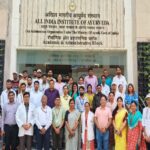- In the last two decades, the incidence and prevalence of Parkinson’s in India has increased to more than 300-400 people per lakh population
- More and more younger people in India are attending specialized movement disorders clinics
Bengaluru, April 10, 2022:
The burden of Parkinson’s Disease and Parkinsonism disorders is rapidly rising in India. Not long ago, Parkinson’s was considered a disease prominent only in Western countries. However, in the last two decades, its incidence and prevalence in India has increased to 300-400 people per lakh population. The WHO has predicted that India would see a massive 200-300% increase in Parkinson’s disease over the next two to three decades. This was said by Dr. Prashanth LK, Parkinson’s Disease & Movement Disorders Specialist at the Center for Parkinson’s Disease & Movement Disorders, Manipal Hospitals, Bengaluru, ahead of the World Parkinson’s Day.
Dr. Prashanth LK, considered Bengaluru’s foremost expert on Parkinson’s disease, said: “Bengaluru has seen a major increase in the number of movement disorders patients in recent years, especially Parkinson’s disease and Parkinsonism disorders, at the specialized Movement Disorders Clinics in the city. According to recently published research covering three major movement disorders clinics at Bengaluru, Mumbai and Kolkata, it was discovered that 65% of total patients coming to these clinics had Parkinsonian disorders.[1] ”
The research revealed some interesting findings about Indian people. Some of the neurodegenerative diseases were found to be common or limited only to India. For example, the SCA-12 (Spinocerebellar ataxia-12) is almost exclusive to the Aggarwal community. Wilson’s disease, a rare but treatable disorder affecting liver and brain, is actually quite common in India. Several different types of Parkinsonism disorders have also been noticed in the Indian population. These atypical parkinsonian disorders account for about a quarter of the movement disorders patients seen at specialized movement disorders clinics, indicating the burden and requirement for more research in these fields, according to Dr. Prashanth LK.
He added: “Another important aspect in India is the changing pattern of Parkinson’s patients at various specialized movement disorders clinics. More and more younger people of less than 40 years of age are attending these clinics now. The reason could include genetics, stress, poor quality of life, etc. This changing age profile is of concern as these people are the breadwinners of the family and at the prime of their professional life. An ongoing study on young onset of Parkinson’s disease has revealed interesting genetic findings regarding the Indian population.”
The amount of research output in India about Parkinson’s disease is limited due to funding constraints. The funding agencies in India are predominantly government bodies, which spread the research funds across entire spectrum of healthcare, rather than providing in-depth funding to age-related diseases. Said Dr. Prashanth LK: “We require dedicated funding for specific disorders to conduct meaningful research that can impact the outcome of care for Parkinson’s patients. In the West, a significant amount of funding comes from private philanthropic agencies and trusts, which exclusively fund research into these disorders. Similar type of funding support from Indian philanthropic groups and trusts would generate dramatic research outcomes from Indian researchers. Indian population has probably different genetic and demographic aspects. With such a great talent pool of researchers catering to this huge population, right funding would help in getting several “Eureka” moments for global science.”
Talking about upcoming therapies on treatment for Parkinson’s patients, Dr. Prashanth LK said: “Work is going on regarding both therapeutic outcomes and understanding the pathophysiology of Parkinson’s. Insights from genetic research have given us hope for specific gene-based therapies for certain subsets of Parkinson’s disease patients. Early trials are going on for possible disease modification and cure-based approaches. We may possibly have dramatic disease modifying therapies over the next couple of decades for Parkinson’s disease.”
The focus of the government in India has usually been on treatable and preventable disorders such as nutritional and infectious diseases. Funding for ageing-related disorders is slowly being increased now, as it is now being appreciated that age-related disorders would constitute major healthcare burden in a few decades in India. “The Government should encourage private funding agencies, philanthropic organizations and CSR initiatives of corporates to be channelled towards improving the care and support system of Parkinson’s disease and other aging disorders. A good government policy impetus can give a boost to research in this field,” said Dr. Prashanth LK.
About 10-15 years back, there used to only 5-10 exclusive Parkinson’s disease specialists in India. In the last 10 years, there has been a sudden increase in the number of neurologists who exclusively specialize in Parkinson’s Disease (called Movement Disorders Specialists). India now has an exclusive society for movement disorders, called Movement Disorders Society of India, which is making impact globally. During the last 10 years, exclusive research groups working for Parkinson’s disease have also been formed, like the Parkinson Research Alliance of India (PRAI), to collaborate, understand and possible get breakthroughs for movement disorders.
healthysoch







